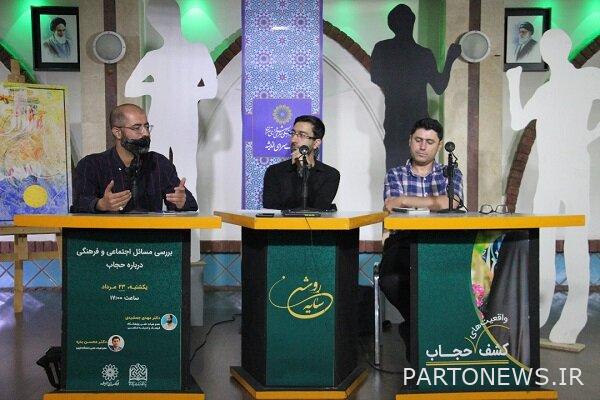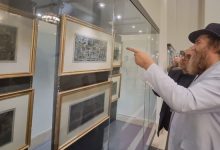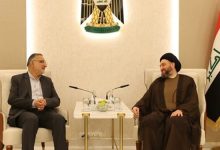It is not possible to promote hijab by force, but the intervention of the government is necessary – Mehr News Agency Iran and world’s news

According to Mehr news agency, the next session of the series of discussion sessions about hijab titled “Discovering the realities of hijab” was held at Andisheh Cultural Center. In this meeting, Mehdi Jamshidi, a member of the Islamic Culture and Thought Research Institute, and Mohsen Badreh, a member of the Al-Zahra University faculty, discussed the cultural and social aspects of the hijab category.
Jamshidi, a member of the academic faculty of the Research Institute of Islamic Culture and Thought, said: When you go to a doctor, if he is a conversationalist, he will ask about the history of your illness, inquire about its developments and then prescribe it. We must go back to the date of birth of this cultural disease and see when its roots were. When I go back to history, I see that until the time of constitutionalism, we did not have a problem called the discovery of hijab and bad hijab, but the history of the last 200 years has many turning points and it seems that everything started from there. Therefore, we have to look for the origins of our current cultural situation in the past.
He added: I believe that the origin of the story goes back to the first Pahlavi and his effort to discover the hijab. This work of his caused the creation of a western-oriented class, which also expanded in the second Pahlavi. This issue caused serious changes in the social structure of our society in different dimensions and somehow cut us off from our past. In other words, our society was culturally manipulated by Westerners. It is for this reason that they say that the Islamic revolution has a cultural nature. It is interesting to know that according to the SAVAK report, in 1356, the number of veiled women increases. This means that the Islamic militant movement realized that something must happen in the depth of its lifestyle. After the Islamic revolution, Imam Khomeini made hijab mandatory, because such a thing came from the heart of the revolution itself.
He continued: From the 1370s onwards, we have seen that the disease of hijab slowly grew in our society. We have to ask the question, what are the roots of this issue? The growth of the western lifestyle, the underperformance of institutions and governance, economic issues and…? Therefore, it can be said that our society was originally a chaste society, Reza Shah started a cultural movement, then the Islamic revolution strengthened the trend towards hijab, but after a decade, it turned back in some parts of the society.
Later, Badreh, a member of Al-Zahra University’s academic faculty, while referring to the history of hijab among Iranians, said: I think it is better to go a little further than the history that Dr. Jamshidi mentioned; In the recent history of several thousand years of civilization, civilized human beings have always had clothes, and women’s and men’s clothes have been very similar to each other. Two of the serious components in this resemblance are that they covered both the head and the middle of the body. In fact, throughout history, headscarves have been shameful for both women and men. The same is true for the middle of the body, which can be seen in the traditional clothes of the Chinese, Indians, Iranians, etc. But with the passage of time, due to cultural changes, the “type of dressing” underwent serious changes. In Iran, men’s clothing changed very quickly and women’s clothing underwent changes with a little distance.
Further, Jamshidi, a member of the scientific faculty of the Research Institute of Islamic Culture and Thought, said about the use of power tools to promote hijab in society: Be careful that the Islamic state is a government that seeks to realize religious values in society. We have to ask the question that does the realization of religion in the society need government and political power? In response, it should be said that some religious values require holding political power. That is, if political power is not in our hands, a huge part of religious values will not be realized. In other words, Islamic revolution happened to promote some values in the society. If religious values were to spread spontaneously in the society, there would be no need for sovereignty, power and revolution.
He continued: Now we have to ask the question whether the religious government should rule religion in the society through force and reluctance? The leader of the revolution says that the religious government creates the ground and provides the platform. There is no force here. In fact, the Islamic society should be such that if a person is left in it, he will become religious by himself. I believe in the intervention of the government, but I do not accept force. That is, the religious government should realize the values, but this work should only happen with moral mechanisms.
In response to Jamshidi’s words about the guidance patrol, Badreh, a member of Al-Zahra University’s faculty, said: “The hijab issue in society is more than a ruling and it should not be seen as superficial.” For example, we say that our teenagers are ugly; The question is, have we talked with them and do we know their worldview? Have we gone to women to know their life experience about this issue? I am not at all in favor of the duality of obligation and discretion, and I think this duality is fake. I see hijab from the point of view of historical anthropology and I say that it existed before Islam. Hijab is our historical and identity issue and it is related to sexual life. In my opinion, there should be another reflection about the wording mentioned by Mr. Jamshidi.
He criticized the record of cultural institutions in this category and added: the important issue is official institutions and cultural institutions. I mean all institutions that are supposed to be in charge of culture in society. Seminaries, Coordination Council of Islamic Propaganda Organization, Supreme Council of Cultural Revolution, universities, etc. are all cultural institutions that should have worked in this field. The question should be asked, how much do these devices know about the field of culture? Look at the members of the Supreme Council of the Cultural Revolution? What is their specialization and function? I believe that we should make serious demands from the cultural institutions, because they do not have an acceptable track record and performed poorly.
In response to Mohsen Badre’s criticism of cultural institutions, Jamshidi said: I also have very serious criticisms of cultural institutions, but it is not possible to make a general judgment about all of them. There are definitely disturbances and that is why the leader of the revolution used the phrase “fire at will”. This shows that cultural institutions are disrupted and closed. On the other hand, the leader of the revolution emphasizes on the “revolutionary reconstruction of the cultural structure”, which shows that he himself is not satisfied with the performance of the cultural institutions. So this issue is undeniable, but I do not tie it to political economy. Martyr Avini has an interpretation and they talk about the phrase “I don’t know, it’s a cultural thing”.

